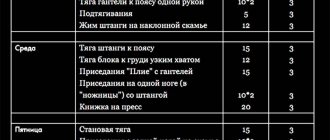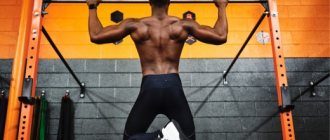Content
- 1 Swimming: the best training programs
- 2 Terminology of the training process
- 3 Tasks for the warm-up part of the workout 3.1 Series 1. Classic
- 3.2 Episode 2. Liberating
- 3.3 Series 3. Non-standard
- 3.4 Episode 4. Technical
- 3.5 Episode 5. Rhythmic
- 3.6 Episode 6. Smooth
- 4.1 Series 1. Classic
- 5.1 Series 1. Classic
- 6.1 Series 1. Classic
- 7.1 Series 1. Classic
- 8.1 Series 1. Classic
- 9.1 Series 1. Classic
- 10.1 Series 1. Classic
How long should you swim in training?
It is believed that for effective training in the pool, an athlete must spend at least an hour in the water. If possible, this time should be 1.5 hours. If you are just starting to swim, you can limit yourself to an hour. Then you should gradually add time spent in the water. Weekend training should be more voluminous than on weekdays.
You should not immediately start swimming for 1.5-2 hours, as there is a risk of overloading the shoulder muscles and even injuries, after which you will have to recover.
Swimming: the best training programs[edit | edit code]
Lesson scheme
In order to create a training series, select task options from this application. We offer representatives of each of the six categories of swimmers special exercises for different stages of the training process. They include:
- warm-up tasks;
- lead-in tasks;
- tasks for practicing technical skills;
- stimulating tasks (tasks at Critical Swimming Speed (CSS));
- endurance challenges (suitable for triathletes preparing to compete in Ironman races and open water swimmers);
- sprint tasks;
- tasks for practicing skills in open water;
- recovery tasks.
The tasks are combined into series to take into account the individual characteristics of swimmers.
- Classic series (good for Arnie).
- Liberating series (suitable for “bambino”).
- Innovative series (well suited for “drummers”),
- Technical series (suitable for gliders).
- Rhythmic series (well suited for swingists).
- Smooth series (pay attention to “smoothies”).
Choose a task that suits your swimming style and mood, and “mix” it with other tasks, building your own workout. Endurance tasks need to be considered separately, since they themselves are already training series, but from all the other exercises you need to create a full-fledged workout. Usually it consists of several required parts.
- Warm-up part.
- Leading part.
- The main part of the training, for which you can choose series: for technique;
- sprint;
- KSP;
- practicing skills in open water.
You can make over 5000 different combinations!
Basic rules of movement in the pool
It is necessary to drive on the right side of the track, with rare exceptions (Japan, UK).
When choosing a path, pay attention to what speed prevails on each one, and choose the most optimal and suitable one. If you make a mistake, it's okay, just change the track.
If you need a rest, stop for a few minutes near the sides along the fronts (the end or beginning of any path), and then continue doing the exercises.
Terminology of the training process[edit | edit code]
We will use abbreviations in the description of tasks and series. Their list is given below.
| v/s- | coordinated freestyle swimming |
| "include"- | it is assumed that there is a certain distance, broken into two (or more) parts, which should be swam continuously, i.e. 25m defined event / 25m freestyle |
| int.— | you need to swim very intensely, in other words, quickly |
| R- | swimming in a certain mode: for example, P = 1:00 (60 s). This means that you must start each segment one minute (60 seconds) after starting the previous segment, i.e. if the mode was set to a distance of 50 m, which you swim in 45 seconds, then you will have 15 seconds left to rest before the next swim |
| usk. 1-4 — | means acceleration on each of the four segments defined in the task. Swim each subsequent segment faster than the previous one, usually this is done in such a way that the last segment is swam at the threshold speed |
| PV- | timed swimming, i.e. swimming over a certain distance with time control |
| HP- | swimming on hands with a bun. Using a knob held between your legs makes it easier to concentrate on practicing your strokes and/or rotating your body. Place the bun as high as possible in the groin area. In tasks with a kolobashka, you can, if desired, use paddles and ropes |
| Heart rate- | heart rate, pulse, measured in beats per minute |
| flippers- | swimming with fins. This involves the use of fins to perform one or another part of the task. |
| + xx s- | a mandatory rest pause of xx s between each part of the task, regardless of what speed was achieved |
| breathing: 3 degrees / 5g.- | inhale after 3 or 5 strokes |
| KSP- | critical swimming speed, determined in time trials at distances of 400 m and 200 m, see chapter 27 |
| KSP ±8 s — | used in the series to indicate greater or lesser speed than KSP. A distance of 100 m is assumed unless otherwise stated |
| TT- | torpedo push. Pushing off from the wall of the pool, while the body should be in a streamlined position: arms extended forward behind the head |
| 3 x (4 x 100 m) - | three series of four segments, each of which is 100 meters, usually all segments in three series are identical |
| ↑/↓ | swimming two segments (there and back). You swim a distance from one end of the pool to the other, completing the task assigned to you (for example, an exercise), and then return, completing another task (for example, just swimming high-speed) |
| PP- | swimming in a straight line. Continuous freestyle swimming, straight |
| KP- | medley swimming. Combined swimming style in the following sequence: butterfly, backstroke, breaststroke, freestyle |
| Legs on the side (to be specified, on the left or right side) - | kicks are performed on the side, with the chest facing one wall of the pool and the back facing the other. The upper hand should remain on the hip, the lower, leading hand should be stretched forward, the ear pressed to the shoulder of the leading hand |
| Harnesses - | you can use an old inner tube from a motorcycle or car, are designed to pull your ankles together to improve muscle control while working to increase your stroke rate |
What are the rules?
Despite the beneficial properties of swimming, it is worth remembering that water and the area around the pool is a place of increased risk of injury and failure to follow the rules can lead to very dire consequences. So before visiting, you should familiarize yourself with the safety equipment and equipment.
Safety precautions
In any swimming pool, regardless of its form of ownership, the following is prohibited:
- jumping from sides, boards or stands without the permission of the instructor;
- pushing while swimming;
- hang on buoys;
- swim across the tracks;
- create obstacles on the path; if you need rest, you need to swim to the side;
- swim with chewing gum;
- walk barefoot near the pool;
- touch technical equipment;
- use equipment for other purposes;
- visit the pool while intoxicated, unwell or if there are contraindications;
- When more than one person is swimming in a lane, each swimmer must stay to the right to avoid collisions.
Each sports complex may also have its own house rules with additional restrictions not mentioned above.
Even more information here.
Schedule
Each pool visitor must follow the class schedule and leave the complex on time. You need to stay in the water for a strictly allotted time, come to training 15 minutes before the start of the lesson and leave the sports complex no later than 30 minutes after its end.
Intensity
The intensity of training is purely individual and depends on physical fitness and the nature of the training. For those who exercise on their own, it is recommended to start with 3 workouts per week, lasting no more than 45 minutes.
Preparation
Proper training for a swimmer does not mean that you need to rush into the pool immediately after changing clothes. for exercises in water , namely:
Warm up. That is, perform muscle stretching, circular movements for the joints, and several strength exercises if the person is in good physical shape.- Get ready psychologically. Water is an unfamiliar environment for the body. It is important to be prepared for possible situations, for example, if you suddenly do not feel the bottom.
- Learn all safety rules on water.
It is also worth noting that it is advisable to enter the water gradually so that the body has time to adapt to new temperature conditions.
Practicing exercises
Those who cannot swim at all are strongly recommended to contact a coach and practice under his guidance.
If you plan to learn exercises using videos from the Internet, you should also remember the rules:
- You should always start practicing in the shallowest part of the pool;
- no need to climb onto the middle paths - the paths for beginners are always on the edges;
- You should try swimming only when you understand how to move your arms and legs; for this you can try doing exercises at the side or with a plank;
- It is advisable to have someone experienced look at whether the exercise technique is being performed correctly or not.
You can see where an absolute beginner should start in this video:
Tasks for the warm-up part of the workout[edit | edit code]
Simple tasks that gradually increase your heart rate.
Episode 1. Classic[edit | edit code]
Target
: Start your workout in a good mood by doing simple exercises.
Tasks
400 m h/s, easy, follow smooth exhalation and bilateral breathing + 30 s
300m HP with bob, ensure good body rotation + 20s
200 m fins ↑ “Broken Arrow” ↓free v/s + 15 s
100 m a/s, smooth and calm
Full distance
1000 m
Episode 2. Liberating[edit | edit code]
Target
Use fins to move smoothly, without tension, to the main part of the workout.
Tasks
2 times 200 m with long fins, smooth footwork, easy breathing + 20 s
2 x 100 m fins ↑6/1/6 ↓v/s + 15 s
2 x 50 m h/s, easy, relaxed + 10 s
Full distance
700 m
Episode 3. Non-standard[edit | edit code]
Target
The joy of life in all its diversity!
Tasks
3 times
Full distance
900 m
Option 1
- 100 m a/s, easy + 10 s
- 2 x 50 m + 10s HP - good grip
- 4 x 25 m + 5s h/s: odd - fast, even - easy
Option 2
fins, breathing: 5 gr. (v/s)
TT, alternating push-off on the chest with push-off on the back
HP with kolobashka, breathing: 1) 3 g.; 2) 5 g; 3) 7 gr.; 4) 3 gr.
Option 3
V/s, calmly and smoothly
fins: 25 m “Shoulder taps” 125 m h/s
V/s - gradual acceleration
Episode 4. Technical[edit | edit code]
Target
Development of coordination of movements and “sense of water”.
Tasks
5 x 200 m + 20 s
- h/s, breathing: 25 m left + 25 m right + 50 m bilateral
- fins ↑6/3/6 — ↓v/s
- h/s, breathing: 25 m left + 25 m right + 50 m bilateral
- HP: 15 m Rowing No. 1 + 85 m h/s
- v/s - at a relaxed pace, calm and relaxed
Full distance
1000 m
Episode 5. Rhythmic[edit | edit code]
Target
Warm-up for more experienced swimmers.
Tasks
2 x 500 m + 30 s
- in coordination - monitor breathing and smoothness of the stroke; constantly maintain an optimal reasonable pace
- HP - in the first and last 200 m = bun and tourniquet;
average 100 m = harnesses only
Full distance
1000 m
Episode 6. Smooth[edit | edit code]
Target
Learn to monitor the rhythm and coordination of breathing.
Tasks
200 m easy h/s - bilateral breathing
200 m HP - respiration: 5 gr.
200 m fins — ↑25 m Unco left +1 25 m h/s ↓25 m Unco right +25 m h/s
200 m HP - alternate sides for breathing every 25 m
200 m easy h/s - bilateral breathing
Features of styles
Classes in the pool involve both exercise and swimming itself. To ensure the desired effect on the spine, it is important to choose the right style of movement in the water. The main techniques are breaststroke, backstroke, butterfly and crawl. More details about them:
- Swimming on your back qualitatively relieves the spine. This style is especially useful for people with varicose veins and the elderly. The technique is also indicated for problems with joints, scoliosis and osteochondrosis. But you cannot swim on your back if you have kyphosis (curvature of the ridge in the thoracic region with a convexity backwards).
- The butterfly style, from a physical point of view, is considered quite difficult. When swimming, the body makes wave-like movements, which uses almost all the muscles of the body. The style is suitable for those who took up swimming to prevent illness, but beginners should hardly start with it.
The butterfly technique effectively prevents back pathologies, strengthens the heart, blood vessels, muscular and respiratory systems. In addition, such swimming burns a lot of calories and promotes weight loss. But it is not recommended to practice butterfly in case of severe diseases of the spine, weakened muscles and reduced immunity.
- The classic version of the crawl style involves moving on the stomach, but there is also a crawl on the back. This technique is physically lighter than the previous one, but heavier than breaststroke. When swimming, the body remains in a horizontal position, and the legs and arms work alternately. In total, the crawl uses about 20 different muscle groups in the shoulders, arms, back and legs. In addition, the style is good for the heart and blood vessels.
Rabbit on the belly has no contraindications and is especially recommended for older people. It is also indicated for kyphosis, hernias, poor posture, muscle weakness and excess weight (promotes weight loss). But when swimming using the crawl technique, it is important not to strain too much, so as not to harm the spine. As for the option on the back, it cannot be used for kyphosis.
- Breaststroke is considered the most harmless style for the spine. Calm and slow, it does not require special skills, instills correct breathing and reduces back pain. The technique develops all muscle groups, but gives rest to the muscles of the cervical and shoulder regions. Contraindications for breaststroke swimming are only conditions that prohibit visiting the pool.
Important! When moving on your stomach, it is possible to avoid stress on the cervical spine in a position where your head is lowered into the water and breathing to the side. In this case, the subtleties of the implementation of leg swings and strokes do not matter.
The technique of performing movements for any style of swimming can be watched at home on videos that are widely presented on the Internet. But it’s better to learn from a trainer directly in the pool.
Recovery part of training[edit | edit code]
Speed table
Designed to gradually reduce the heart rate and remove metabolic products from the body.
Episode 1. Classic[edit | edit code]
Target
Relieve tension from the muscles of the shoulder girdle.
Tasks
100 m easy v/s
100m fins ↑"Broken Arrow" ↓v/s 100m easy HP, good body rotation
Full distance
300 m
Episode 2. Liberating[edit | edit code]
Target
Falling in love with the water, even stopping at the deep end of the pool every time to dive three times.
Exercise
200 m fins - strokes are long and smooth, watch your exhalation
Full distance
200 m
Episode 3. Non-standard[edit | edit code]
Target
Favorite series! The easiest way to relax!
Exercise
200 m with 2 x 50 m easily in/s
50m backstroke: arms - simultaneously, legs - breaststroke
Episode 4. Technical[edit | edit code]
Target
Try to control your speed while continuing to swim smoothly and consistently.
Exercise
6 x 50 m + 10 s, speed decreases by 2 s every 50 m, at the end very slowly
Full distance
300 m
Episode 5. Rhythmic[edit | edit code]
Target
Gradually reduce the stroke frequency, the movements remain smooth.
Exercise
6 x 50 m + 15 s, stroke rate decreases by 2 G/min every 50 m
Full distance
300 m
Episode 6. Smooth[edit | edit code]
Target
Finish your workout smoothly!
Tasks
100 m easy v/s
100 m HP
100 m high-quality fins
Full distance
300 m










